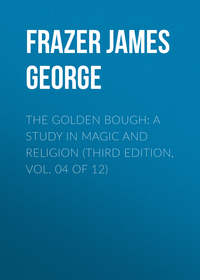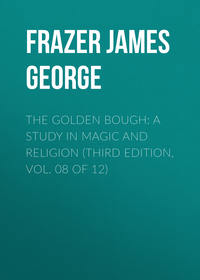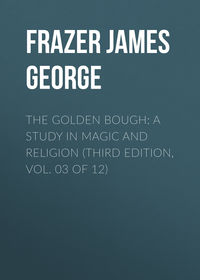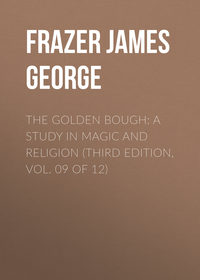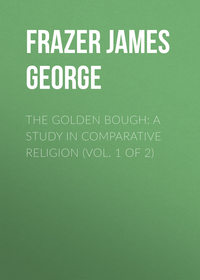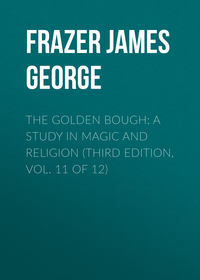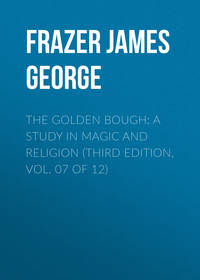 полная версия
полная версияThe Belief in Immortality and the Worship of the Dead, Volume 2 (of 3)
724
J. Cook, Voyages, i. 157-159. The great pyramid was afterwards visited and described by the first missionaries. Their measurements confirm, while slightly exceeding, those of Captain Cook. They speak, however, of ten steps instead of eleven, and say that the lowest step was six feet high and the rest about five. See J. Wilson, op. cit. pp. 207 sq., with the plate.
725
D. Tyerman and G. Bennet, op. cit. i. 265 sq.
726
D. Tyerman and G. Bennet, op. cit. i. 13 sq.
727
W. Ellis, op. cit. i. 341.
728
D. Tyerman and G. Bennet, op. cit. ii. 13.
729
W. Ellis, op. cit. i. 341 sq.
730
J. Wilson, op. cit. p. 351.
731
Above, pp. 116 sqq.
732
J. Cook, Voyages, i. 217.
733
J. Cook, op. cit. i. 219.
734
J. Cook, Voyages, vi. 37.
735
J. Cook, Voyages, vi. 40 sq.
736
G. Forster, Voyage round the World, i. 267.
737
D. Tyerman and G. Bennet, op. cit. i. 271.
738
D. Tyerman and G. Bennet, op. cit. i. 280.
739
W. Ellis, op. cit. i. 405. See above, pp. 117 sq.
740
J. Wilson, op. cit. p. 364.
741
J. A. Moerenhout, op. cit. i. 470.
742
A. Baessler, Neue Südsee-Bilder, pp. 116 sq., 127 sq., 144 sq.
743
A. Baessler, op. cit. pp. 130, 131.
744
A. Baessler, op. cit. p. 119.
745
A. Baessler, op. cit. pp. 117 sq.
746
A. Baessler, op. cit. pp. 130 sq.
747
A. Baessler, op. cit. p. 140.
748
A. Baessler, op. cit. p. 127.
749
A. Baessler, op. cit. pp. 124, 141.
750
A. Baessler, op. cit. pp. 127 sq., 144 sq.
751
See below, p. 311.
752
Ellis says, "I am not aware that they rendered divine homage either to the sun or moon" (Polynesian Researches, iii. 171). Speaking of the Areois, Moerenhout says that "it seems to me clear that though they did not adore directly the sun and the other stars, nevertheless their worship was little else than sabeism or the adoration of the visible and animated universe" (op. cit. i. 503). He interpreted both Oro and Maui or Mahoui (as he spells the name) as the sun-god (op. cit. i. 484, 502, 503, 560 sq.); but these interpretations appear to be his own guesses, unsupported by any statement of the natives. Maui was the great Polynesian hero, one of whose most famous exploits was catching the sun in a snare and compelling him to move more slowly (E. Tregear, Maori-Polynesian Comparative Dictionary, pp. 234 sqq., s. v. "Maui"; see above, p. 275); but this story, far from favouring the identification of Maui with the sun, seems fatal to it. According to J. R. Forster, the great god Taroa (Taaroa) was thought to have created the sun and to dwell in it (Observations, p. 540); but even if this statement is correct, it hardly implies a worship of the sun. With regard to the moon, the same writer tells us (l. c.) that it was supposed to be procreated by a goddess named O-Heena, "who presides in the black cloud which appears in this luminary"; and the statement is repeated by his son, George Forster, who adds: "The women sing a short couplet, which seems to be an act of adoration paid to that divinity [O-Heena], perhaps because they suppose her to have some influence upon their physical œconomy… 'The cloud within the moon, that cloud I love'" (Voyage round the World, ii. 152). This so far seems to imply a reverence for the moon; and there are some grounds for thinking that O-Heena or Hina (as the name is usually spelt) was in Eastern Polynesia a moon-goddess. See above, p. 267, note2.
753
W. Ellis, op. cit. i. 331 sq., iii. 171. According to another account, the sun and moon in eclipse were supposed to be in the act of copulation. See J. Wilson, op. cit. p. 346.
754
J. A. Moerenhout, op. cit. i. 468.
755
W. Ellis, op. cit. i. 348 sq.
756
J. Cook, Voyages, i. 224; J. R. Forster, Observations made during a Voyage round the World, p. 547; J. A. Moerenhout, op. cit. i. 469. Elsewhere (vi. 149) Captain Cook mentions that the baring of the body on the approach to a temple was especially incumbent on women, who otherwise had to make a considerable circuit to avoid the sacred edifice.
757
J. A. Moerenhout, op. cit. i. 469 sq.; A. Baessler, Neue Südsee-Bilder, pp. 126 sq.
758
J. A. Moerenhout, op. cit. i. 536 sq.
759
W. Ellis, op. cit. i. 271 sq.
760
D. Tyerman and G. Bennet, op. cit. i. 558.
761
D. Tyerman and G. Bennet, op. cit. i. 267 sq.
762
A. Baessler, Neue Südsee-Bilder, pp. 124, 141; D. Tyerman and G. Bennet, op. cit. i. 529 sq.
763
A. Baessler, op. cit. p. 142.
764
A. Baessler, op. cit. p. 146.
765
W. Ellis, op. cit. i. 337 sq.; J. A. Moerenhout, op. cit. i. 471. According to Ellis, the wooden images were made from the durable timber of the aito or casuarina tree, and the stone images were mostly rude uncarved angular columns of basalt, of various sizes, though some were of calcareous or siliceous stone. Some stone images, however, were rudely carved in human form. See A. Baessler, Neue Südsee-Bilder, pp. 128 sq.
766
W. Ellis, op. cit. i. 354.
767
W. Ellis, op. cit. i. 338 sq.; J. A. Moerenhout, op. cit. i. 471 sqq.
768
J. A. Moerenhout, op. cit. i. 473 sq.
769
W. Ellis, op. cit. i. 344 sq.
770
W. Ellis, op. cit. i. 345-348. Compare J. Cook, Voyages, iii. 168 sqq. vi. 28-41; J. Wilson, op. cit. pp. 350 sq.; D. Tyerman and G. Bennet, op. cit. i. 549, ii. 38 sq.
771
W. Ellis, op. cit. i. 342 sq. Compare J. R. Forster, Observations made during a Voyage round the World, pp. 545 sqq.; J. A. Moerenhout, op. cit. i. 474 sqq.
772
J. Wilson, op. cit. p. 348.
773
J. Cook, Voyages, i. 223.
774
D. Tyerman and G. Bennet, op. cit. i. 279.
775
J. Wilson, op. cit. pp. 349 sq.
776
W. Ellis, op. cit. i. 373-375.
777
W. Ellis, op. cit. i. 373 sq.
778
D. Tyerman and G. Bennet, op. cit. i. 124.
779
D. Tyerman and G. Bennet, op. cit. i. 114 sq.
780
D. Tyerman and G. Bennet, op. cit. i. 121.
781
J. A. Moerenhout, op. cit. i. 504-507.
782
G. Forster, Voyage round the World, ii. 151 sq. Compare J. R. Forster, Observations made during a Voyage round the World, pp. 534 sq., 542 sq., where the word for soul is given as E-teehee or Teehee.
783
J. A. Moerenhout, op. cit. i. 431.
784
G. Forster, op. cit. ii. 151 note *.
785
J. Cook, op. cit. vi. 151.
786
J. A. Moerenhout, op. cit. i. 430.
787
J. Wilson, op. cit. p. 346. In the Polynesian languages po is the word both for "night" and for "the shades," the primaeval darkness from which all forms of life were evolved, and to which the souls of the dead return. See E. Tregear, Maori-Polynesian Comparative Dictionary, p. 342, s. v. "po."
788
W. Ellis, Polynesian Researches, i. 378 sq.
789
Compare W. Ellis, op. cit. i. 396, "What their precise ideas of a spirit were, it is not easy to ascertain. They appear, however, to have imagined the shape or form resembled that of the human body, in which they sometimes appeared in dreams to the survivors."
790
J. Cook, op. cit. vi. 150.
791
J. A. Moerenhout, op. cit. i. 507.
792
W. Ellis, op. cit. i. 395; J. A. Moerenhout, op. cit. i. 433, 538 sqq.
793
W. Ellis, op. cit. i. 395 sq.
794
See above, p. 49.
795
J. A. Moerenhout, op. cit. i. 538 sq.
796
J. A. Moerenhout, op. cit. i. 539-541. Compare W. Ellis, op. cit. i. 363 sqq.
797
J. A. Moerenhout, op. cit. i. 543.
798
J. Wilson, op. cit. p. 345.
799
J. Wilson, op. cit. p. 404.
800
W. Ellis, op. cit. i. 396.
801
W. Ellis, op. cit. i. 398 sq.
802
W. Ellis, Polynesian Researches, i. 407-409; J. Wilson, op. cit. p. 352; J. A. Moerenhout, op. cit. i. 546 sq.
803
J. A. Moerenhout, op. cit. i. 551 sq.
804
J. Cook, Voyages, i. 135, 218; J. R. Forster, Observations made during a Voyage round the World, p. 560.
805
W. Ellis, op. cit. i. 410.
806
J. Cook, Voyages, i. 218; J. R. Forster, Observations made during a Voyage round the World, p. 560.
807
J. Wilson, op. cit. pp. 352 sq.
808
J. Cook, Voyages, i. 218 sq.
809
W. Ellis, op. cit. i. 410; J. Wilson, op. cit. pp. 196, 362.
810
See Folk-lore in the Old Testament, ii. 82 sqq.
811
W. Ellis, op. cit. i. 406.
812
W. Ellis, op. cit. i. 401-403. Compare J. A. Moerenhout, op. cit. i. 552.
813
W. Ellis, op. cit. i. 412 sq. Compare J. Cook, Voyages, i. 135 sq., 138, 219; J. A. Moerenhout, op. cit. i. 547-549.
814
G. Forster, Voyage round the World, ii. 74. For the full description of the garb, see id., ii. 71-75; J. R. Forster, Observations made during a Voyage round the World, pp. 450-453.
815
J. Cook, Voyages, i. 138 sq., 219; J. R. Forster, Observations made during a Voyage round the World, pp. 560 sq.; W. Ellis, op. cit. i. 413 sq.; J. A. Moerenhout, op. cit. i. 549 sq. According to Ellis, the mummers were supposed to be inspired by the spirit of the deceased; according to Moerenhout, they were not inspired by, but merely represented, the ghost. The difference between spiritual representation and inspiration is somewhat fine; too fine perhaps to be apprehended by Tahitian intelligence. Forster says that the procession started from the house of the deceased, Ellis that it started from a valley.
816
D. Tyerman and G. Bennet, Journal of Voyages and Travels, i. 322.
817
W. Ellis, op. cit. i. 399 sq.
818
J. A. Moerenhout, op. cit. i. 553 sq.
819
W. Ellis, op. cit. i. 400.
820
W. Ellis, op. cit. i. 404.
821
J. Cook, Voyages, i. 93 sq., 135, 217, 218; J. Wilson, op. cit. pp. 84, 212 sq.; W. Ellis, op. cit. i. 404; J. A. Moerenhout, op. cit. i. 547.
822
J. Cook, op. cit. i. 217 sq. Compare J. R. Forster, Observations made during a Voyage round the World, p. 559.
823
J. Cook, Voyages, i. 93 sq., 135 sq., 218, 219, vi. 47 sq.; J. R. Forster, Observations made during a Voyage round the World, pp. 561 sq.; J. Wilson, op. cit. pp. 212 sq., 363 sq.; W. Ellis, op. cit. i. 400 sq., 404 sq., 405 sq.; J. A. Moerenhout, op. cit. i. 554.
824
W. Ellis, op. cit. i. 272, who observes that the survivors "considered the spirits of the proprietors of these skulls as the guardian spirits of the family."
825
W. Ellis, op. cit. i. 405.
826
A. Baessler, Neue Südsee-Bilder (Berlin, 1900), pp. 37 sq., 81 sq., 83.
827
J. Wilson, op. cit. p. 364.
828
W. Ellis, op. cit. i. 403.
829
J. Wilson, op. cit. p. 363.
830
See above, p. 305.
831
W. Ellis, op. cit. i. 403.
832
J. Wilson, op. cit. p. 364.
833
J. Cook, Voyages, i. 222, vi. 150.
834
J. Wilson, op. cit. p. 345.
835
J. R. Forster, Observations made during a Voyage round the World, pp. 552, 553; G. Forster, Voyage round the World, ii. 151 sq.
836
J. R. Forster and G. Forster, ll.cc.
837
W. Ellis, Polynesian Researches, i. 348, "the unus, or curiously carved pieces of wood marking the sacred places of interment, and emblematical of tiis or spirits."
838
G. Forster, op. cit. i. 267. Compare J. A. Moerenhout, op. cit. i. 461, "Les images des Tiis étaient placées aux extrémités des marais et gardaient l'enceinte des terres sacrées."
839
J. R. Forster, op. cit. pp. 544 sq. In the southern peninsula of Tahiti, both on the coast and inland, Captain Cook saw many sepulchral buildings, and he described them as "decorated with many carved boards, which were set upright, and on the top of which were various figures of birds and men: on one in particular there was the representation of a cock, which was painted red and yellow, to imitate the feathers of that animal, and rude images of men were, in some of them, placed one upon the head of another." See J. Cook, Voyages, i. 150 sq. These "carved boards" were no doubt of the same sort as the tees or teehees described by the two Forsters. No other writer seems to mention the figures of birds carved on them.
840
J. R. Forster, op. cit. p. 543.
841
W. Ellis, op. cit. i. 396. Compare J. Wilson, op. cit. p. 346; J. A. Moerenhout, op. cit. i. 431; D. Tyerman and G. Bennet, op. cit. i. 330.
842
W. Ellis, op. cit. i. 396 sq.; J. A. Moerenhout, op. cit. i. 433.
843
D. Tyerman and G. Bennet, Journal of Voyages and Travels, i. 273; compare ib. pp. 330 sq.
844
D. Tyerman and G. Bennet, op. cit. i. 521 sq.
845
J. Cook, Voyages, vi. 150.
846
J. Wilson, op. cit. pp. 345 sq.
847
J. Cook, Voyages, vi. 150 sq.
848
See above, pp. 87 sq., 214 sqq., 238 sqq.
849
D. Tyerman and G. Bennet, op. cit. i. 537 sq.
850
D. Tyerman and G. Bennet, op. cit. i. 331 sq.
851
D. Tyerman and G. Bennet, op. cit. i. 522.
852
J. A. Moerenhout, op. cit. i. 455.
853
J. Cook, i. 222. Compare id., vi. 150; J. R. Forster, Observations made on a Voyage round the World, pp. 553 sqq.
854
W. Ellis, op. cit. i. 397. Compare J. A. Moerenhout, op. cit. i. 433.
855
See above, p. 317.
856
W. Ellis, op. cit. i. 245 sq., 397; J. A. Moerenhout, op. cit. i. 434 sq.
857
J. Williams, Narrative of Missionary Enterprises in the South Sea Islands, p. 476.
858
J. R. Forster, Observations made during a Voyage round the World, p. 553; G. Forster, Voyage round the World, ii. 151.
859
See above, pp. 299 sqq.
860
J. Cook, Voyages, vi. 152.
861
A. Baessler, Neue Südsee-Bilder, p. 37.
862
A. Baessler, op. cit. pp. 83 sq.
863
A. Baessler, op. cit. pp. 81 sq.
864
J. Wilson, op. cit. p. 344.
865
T. Wilson, op. cit. p. 343.
866
J. Wilson, op. cit. p. 345. "The general name for deity, in all its ramifications, is eatooa" (id. p. 343).
867
J. Wilson, p. 346.
868
In confirmation of my conjecture that the missionaries mistook a general name (tee, otherwise spelled tii) for the name of a particular demon, I may point out that the naturalist J. R. Forster before them seems to have fallen into precisely the same mistake with regard to another general name for departed spirits (oramatuas or oromatuas). Thus he writes: "Besides these divinities of the second class, there are others of a still inferior rank, and though called Eatooas, are no more than what the Greek or Roman mythologists would have called Genii, or Dii minorum gentium: one of them, called Orometooa, is of a malignant disposition, resides chiefly near the Marais and Toopapous (places of burial) and in or near the boxes, or little chests, including the heads of their deceased friends, each of which, on that account, is called Te-wharre no te Orometooa, the house of the evil genius Orometooa, The people at Taheitee are of opinion, that if their priests invoke this evil genius, he will kill, by a sudden death, the person on whom they intend to bring down the vengeance of this divinity." See J. R. Forster, Observations made during a Voyage round the World, pp. 541 sq. In this passage we can hardly doubt that "this evil genius," Orometooa, is simply the oramatuas or oromatuas, the spirits of the dead, by means of whom sorcerers were supposed to injure or destroy any one at whom they or their employers had a grudge. See above, p. 299, and below, pp. 323 sqq.
869
W. Ellis, Polynesian Researches. i. 334-336.
870
W. Ellis, op. cit. i. 337.
871
W. Ellis, op. cit. i. 363.
872
W. Ellis, op. cit. i. 363-370.
873
W. Ellis, op. cit. iii. 112, 125.
874
J. Williams, Narrative of Missionary Enterprises in the South Sea Islands, pp. 466 sq.
875
D. Tyerman and G. Bennet, op. cit. i. 254 sq. As to Hiro, the god of thieves, see also J. A. Moerenhout, op. cit. i. 447-449.
876
W. Ellis, Polynesian Researches, i. 351 sq. Compare J. A. Moerenhout, op. cit. i. 502 note1, 523.
877
Captain J. Cook, Voyages, iii. 274 sqq.; G. Forster, Voyage round the World, ii. 5 sqq.; C. P. Claret Fleurieu, Voyage round the World performed by E. Marchand (London, 1801), i. 27 sqq., 55 sqq.; J. Wilson, Missionary Voyage to the Southern Pacific Ocean, pp. lxxiii. sqq., 127 sqq.; A. J. von Krusenstern, Voyage round the World (London, 1813), i. 136; Vincendon-Dumoulin et C. Desgraz, Îles Marquises ou Nouka-hiva (Paris, 1843), pp. 1 sqq., 12 sq.; Le P. Mathias G – , Lettres sur les Îles Marquises (Paris, 1843), pp. 7 sqq.; P. E. Eyriaud des Vergnes, L'Archipel des Iles Marquises (Paris, 1877), pp. 1 sqq.; C. E. Meinicke, Die Inseln des Stillen Oceans, ii. 235 sq.; F. H. H. Guillemard, Australasia, ii. 522.
878
As to the formation and scenery of the islands, see Krusenstern, op. cit. i. 110; C. S. Stewart, Visit to the South Seas (London, 1832), i. 193 sqq.; F. D. Bennett, Narrative of a Whaling Voyage round the Globe (London, 1840), i. 299 sqq.; H. Melville, Typee, pp. 8 sq., 17 sq., and passim (Everyman's Library); Vincendon-Dumoulin et C. Desgraz, op. cit. pp. 138 sq.; P. E. Eyriaud des Vergnes, op. cit. pp. 84 sq.; Clavel, Les Marquisiens (Paris, 1885) pp. 1 sq.; C. E. Meinicke, op. cit. ii. 236 sq.; F. H. H. Guillemard, op. cit. pp. 522 sq.; A. Baessler, Neue Südsee-Bilder (Berlin, 1900), pp. 192 sq., 220 sqq. As to the extreme difficulty of scaling the mountains and precipices to pass from one valley to another, see particularly M. Radiguet, Les Derniers Sauvages (Paris, 1882), pp. 101 sq., note.


